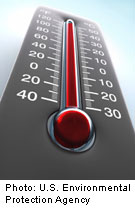
TUESDAY, July 12 (HealthDay News) — Scorching heat and oppressive humidity continued to grip much of the United States Tuesday, with temperatures exceeding 90 degrees — and in some cases 100 degrees — from the Southwest to the Northeast.
The heat wave is prompting doctors to warn that high temperatures can cause serious — and potentially fatal — health problems.
“The body has ways of keeping itself cool, by letting heat escape through the skin, and by perspiring,” said Dr. Ken Sable, vice chair of emergency medicine at Maimonides Medical Center in New York City, where the mercury was expected to top out at 95 degrees on Tuesday.
“If the body does not cool properly or does not cool enough, the victim may suffer a heat-related illness. Anyone can be susceptible although the very young and very old are at greater risk. Heat-related illnesses can become serious or even deadly if unattended,” he added.
Dr. Janyce Sanford, chair of emergency medicine at the University of Alabama at Birmingham Hospital, said heat-related illnesses span a range of ills, from mild to severe. “Someone who has been working out in the heat may start to experience the beginning stages with heat cramps. As it progresses, the next step is heat exhaustion. They may develop a severe headache, nausea, vomiting, and a feeling of severe weakness,” she said in a university news release.
The most serious — and potentially fatal — heat-related illness is heat stroke, Sanford said.
“When you reach this point, the severely elevated body temperature causes an altered mental state, dizziness and ultimately can lead to a loss of consciousness. The muscles can start to break down, which leads to kidney failure; this makes heat stroke a life-threatening illness,” she said.
Though rare, heat stroke is most often seen in very young and elderly people, or people with a chronic illness.
Sable said the safest place to be during a heat wave is indoors — if air conditioning is available. Remain in the air-conditioning as long as possible. And limit outdoor activity to morning and evening hours when temperatures are relatively cooler.
Sanford offers the following advice:
- Avoid being outside during the hottest part of the day, 11 a.m. to 4 p.m. Wear light-colored and lightweight clothing, a hat, and remember that 100 percent cotton clothing tends to hold sweat, making it harder for your body to cool off.
- Thirst isn’t always a good sign of hydration status. In children, the thirst mechanism isn’t fully developed, and in seniors, the sense of thirst has diminished. By the time your brain signals thirst, you may have lost 1 percent of your body weight — about 3 cups of sweat for a 150-pound person.
- Urine color is an important indicator of hydration. A well-hydrated person’s urine will be almost clear. Darker colors indicate less hydration. Not having to urinate at all after intense workouts is a warning sign of real dehydration.
- If you exercise for less than 90 minutes at a time, cool water (40 degrees F) is all you need to replace fluids. You should drink about 16 ounces of water two hours before exercising, eight ounces every 15 to 20 minutes during exercise, and then at least another 16 ounces after finishing. Drink until your thirst is quenched, and then drink even more to fully rehydrate.
- Sports beverages are appropriate if you’re exercising for more than 90 minutes. These beverages should be consumed only during exercise and not before, because they might trigger a hypoglycemic — or low glucose — effect, potentially reducing performance.
Sable said it’s also best to avoid caffeine and alcohol. Drinks that contain caffeine, alcohol, or large amounts of sugar can cause dehydration and irritability.
The National Weather Service said the excessive heat would continue over much of the eastern two-thirds of the country on Tuesday, with excessive heat warnings and heat advisories in place from parts of Texas and Oklahoma, eastward across the Plains states and Mississippi Valley, into the Gulf Coast states, southeastern United States, and the Mid-Atlantic region. Air quality alerts are in effect across the eastern United States, including parts of New Jersey, Pennsylvania, Maryland, Virginia, North Carolina, and Georgia.
The cause of the heat wave is a high-pressure system that has remained stuck over much of the middle of the country, blocking the arrival of cooler air from Canada. In Wichita, the temperature has hit at least 100 degrees for 20 straight days.
If you’re looking for some (very) long-range relief from the heat, don’t count on it. A recent study from Stanford University predicts that scorching temperatures would become the new norm, with unusually hot summers by the middle of the century. The culprit cited by the researchers: global warming.
More information
For more on protecting yourself from the heat, visit the U.S. Centers for Disease Control and Prevention.

